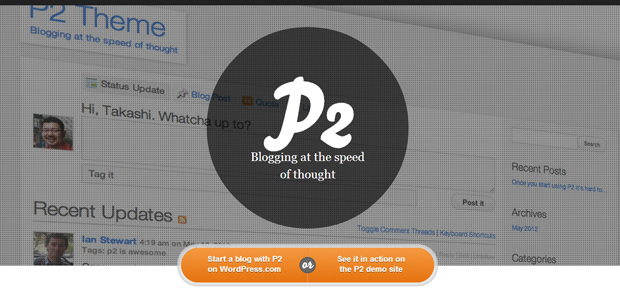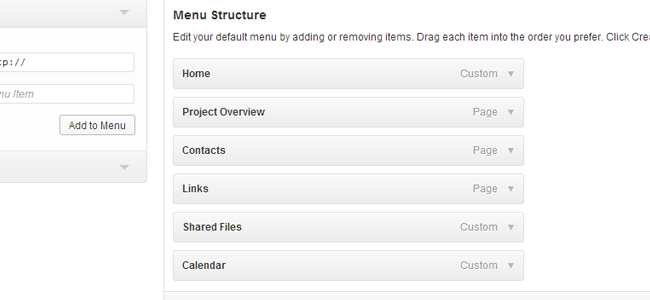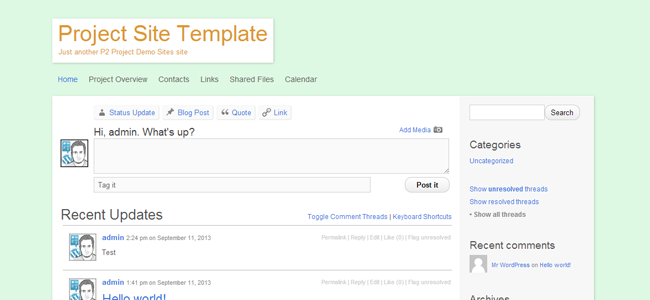
In this series of posts we’re going to build a free, WordPress-powered alternative to popular project management web apps.
In last week’s post we covered:
- The goal of building a secure and private system. Every client should have a unique site.
- The essential ingredients: a web host that can run WordPress; the latest version of WordPress; the P2 theme from Automattic; and a handful of essential plugins.
- Getting things started: installing WordPress; enabling multisite; setting up our plugins; setting up a separate service for storing/sharing files (because WordPress really isn’t the best too for syncing and sharing stuff like that).
In today’s post we’re going to create the P2 Project Site template.
The idea here is that we’re going to:
- Set up a dummy P2 site that we’ll replicate for all new clients/projects.
- Use the Blog Copier plugin that we installed to simplify the replication process.
Let’s get started.
Setting Up your P2 Template
Log into WordPress and go to your Network Admin Dashboard.
On the sidebar, under Sites, click Add New.
Enter the address and site title. Keep it simple and distinct. e.g.) something like “template” or “base”, something that you’ll immediately recognize and not get confused with a potential client project.
Enter your email address for the Admin Email.
Click Add Site.
WordPress may take a moment to set up the new site. Once it’s done, you’ll see a yellow alert message saying “Site Added”. Click the Visit Dashboard link to go to the template site’s WordPress dashboard.
Enable the P2 Theme
The first thing we want to do is enable the P2 Theme. Click Appearance. Under Available Themes, click Activate for the P2 theme.
Customize the Theme
P2, out of the box, is kinda bland. Under Appearance, explore the Customize and Theme Options screens to see what you can customize. By tidying up your template site to align more closely with your own brand, you’ll have a graceful fallback if you don’t do any customization on a per-project basis.
Set Up Your Pages
The pages you need will depend on the type of work you do. The following are handy across most projects, though:
- Contacts: A list of all team members and any other important contacts.
- Project Overview: Scope of the project, deliverables, and a timeline.
- Links: Important links to other websites, assets, resources, and so on.
- Introduction/Onboarding: A welcome message for project members.
Keep in mind that these pages are placeholders. You’ll be fleshing them out in more detail for each one of your projects. Simply creating the pages and adding some subheadings or temporary placeholder text (e.g. “The purpose of this page is…”) will do for now.
Set Up Your Navigation Menu
Next we’re going to add some placeholder items to the navigation menu. Under Appearance, click Menus.
Your pages should already be visible in the menu items list. If they’re not, add them from the Pages dropdown on the left side of the Edit Menus screen.
From the Links dropdown, use a hashtag sign (#) for the URL. This’ll be placeholder that will be replaced for each of your project sites.
As with the pages, the links you use will depend on your project. The following are good standbys:
- Calendar: If using a central team calendar like Google Calendar, this will link to the calendar URL.
- Shared Files: Links to the Dropbox, SkyDrive, Google Drive, etc… URL for project files.
If you have a number of useful, often-used links for your project, consider collecting them under relevant dropdown menus for quick access (rather than having project members go through the “Links” page every time).
Click over to the Manage Locations tab and set the Primary Menu to the menu you just created.

Create your Categories
Under Posts, click Categories. You’ll notice that we’re going through a recurring theme here of creating placeholders. The Categories are no different. The names you use depend on your projects. Ideas for standard ones to use:
- Announcements: For important announcements about the project.
- Support: A request for help.
- Bug: If you’re working on development projects, this lets you filter out bug reports (something’s broken) from generic help requests.
- Discussion: For general discussion, brainstorming, and so on.
The P2 theme supports different post formats, which when used in combination with smartly-named categories can prove to be very robust.
Set Up your Widgets
Our final step is to set up the sidebar widgets. (This is where those plugins we installed previously will come into play.) Under Appearance, click Widgets.
The widgets you use and the order they appear in are up to you. As always, we have some suggestions:
- Search: For users to quickly search the site for information.
- Categories: View different types of posts/updates on the site.
- P2 Filter Posts: Toggle between Resolved and Unresolved posts from the project site.
- P2 Recent Comments with Avatars: See the comments that have been left recently, along with avatars for each user.
- Archives: Jump to a specific month.
- Calendar: Near the bottom since it’s used, but not used often. This is handy for active project sites where you need to review updates from a specific date.
- Who’s Online: Listing of users who are also logged in and viewing the site.
These are just some suggestions, of course. Use whatever combination of widgets you think make sense. Since we’re setting up your project site template, the widget choice and arrangement should be one that works for you across the majority of your projects.
Take a look at your project site. Finesse it to your liking. Here’s mine, for inspiration 😉

Next Week: Replicating The Template + Daily Usage
Last week we got our multisite network set up. This week we created our template site.
Next week we’re going to replicate the template and dive into the day-to-day usage of your new project site.
Until then, here’s Beau Lebens talking about O2, the next generation of P2:
